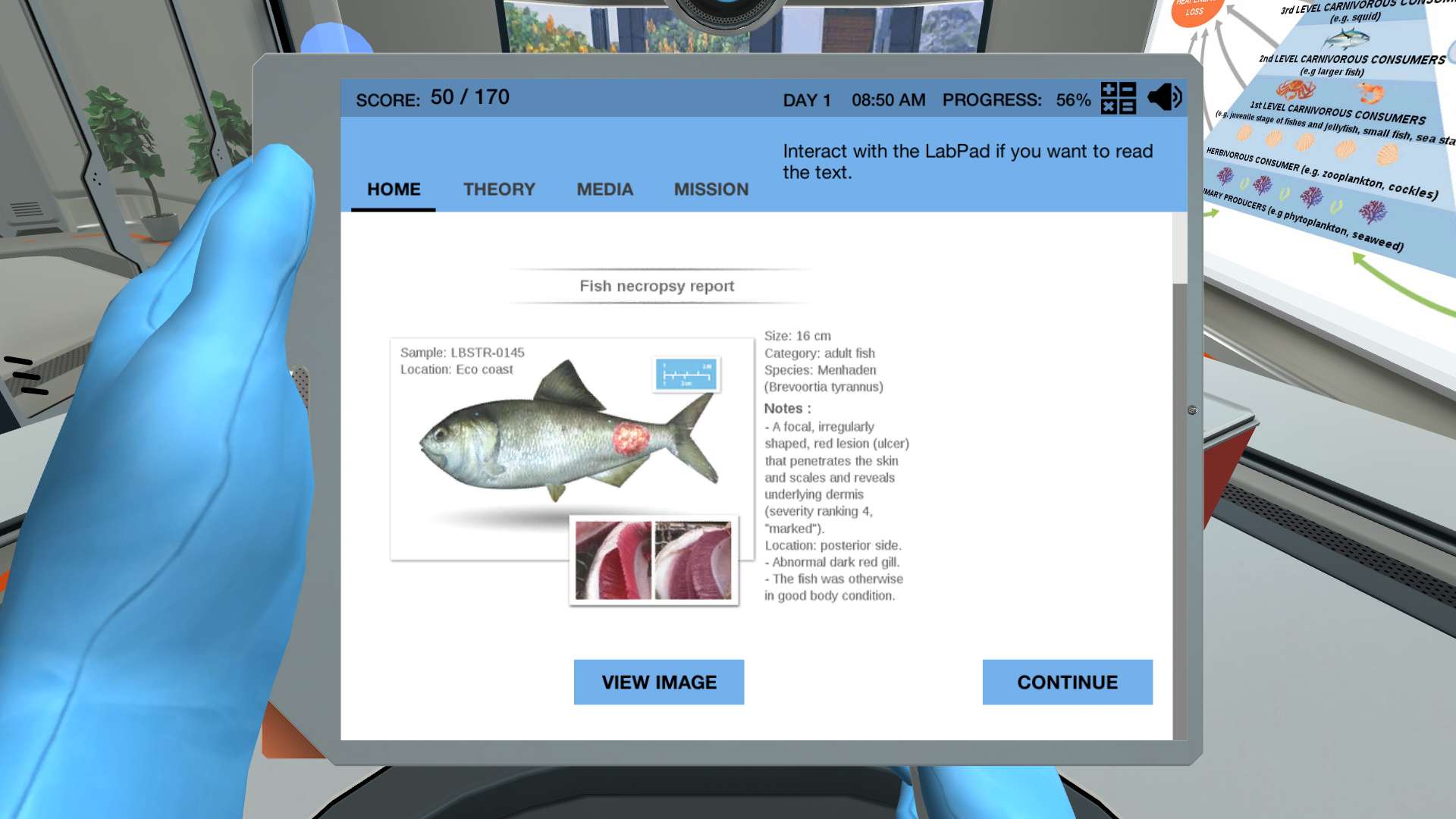Heading 1
Heading 2
Heading 3
Heading 4
Heading 5
Heading 6
Lorem ipsum dolor sit amet, consectetur adipiscing elit, sed do eiusmod tempor incididunt ut labore et dolore magna aliqua. Ut enim ad minim veniam, quis nostrud exercitation ullamco laboris nisi ut aliquip ex ea commodo consequat. Duis aute irure dolor in reprehenderit in voluptate velit esse cillum dolore eu fugiat nulla pariatur.
Block quote
Ordered list
- Item 1
- Item 2
- Item 3
Unordered list
- Item A
- Item B
- Item C
Bold text
Emphasis
Superscript
Subscript
About This Simulation
Become an environmental investigator and solve a massive fish kill mystery. First, learn about the different trophic levels of the ecosystem. You will then perform a fish necropsy and use a spectrophotometer to analyze oxygen levels in the water.
Learning Objectives
- Understand the basic concepts of sample collection
- Perform fish necropsy and learn the information you can get from this kind of approach
- Learn the concepts of trophic levels, trophic pyramids and the energy flow in an ecosystem
- Learn the difference between heterotroph and autotroph organisms
- Analyze the level of dissolved oxygen level in your water sample using a spectrophotometer
- Learn the concepts of a calibration curve, linear regression and extrapolation
About This Simulation
Lab Techniques
- Spectrophotometry
- Fish dissecting
- Sampling
Related Standards
- High level content, may support HS-ESS3-4, HS-ESS3-6
- Unit 8: Ecology
- High level content, may support:
- No direct alignment
Learn More About This Simulation
Can you get to the bottom of a mysterious massive fish-killing? In this simulation, you will be an environmental investigator to solve this fish kill mystery. You will learn about oxygen levels in water and its impact on fish, and energy flow in an aquatic food web. You will perform a fish necropsy and analyze the level of dissolved oxygen by gathering data from fish and water samples to help test your hypothesis.
Analyze the oxygen levels in water
You will first have to collect water samples from the bay where the fish were found. Using a spectrophotometer, you will compare these samples to known values to investigate whether low oxygen in the lake could have caused the massive fish death. Do the fish exhibit symptoms that correlate with low oxygen levels?
Dissection of a fish
Complete a fish necropsy without getting your hands dirty! Dive into the dissection to examine how the fish’s physiological responses can shed some light on the cause behind the fish death. In this simulation, you can skip the long waiting times that would normally occur in real-life necropsies and immediately get your hands on the results to continue your investigation.
Solve the mystery
In this fish-killing investigation, you will have to gather several pieces of information that you will need to figure out what caused the massive fish death. Will you be able to put the pieces together to solve the mystery?
For Science Programs Providing a Learning Advantage
Boost STEM Pass Rates
Boost Learning with Fun
75% of students show high engagement and improved grades with Labster
Discover Simulations That Match Your Syllabus
Easily bolster your learning objectives with relevant, interactive content
Place Students in the Shoes of Real Scientists
Practice a lab procedure or visualize theory through narrative-driven scenarios


FAQs
Find answers to frequently asked questions.
Heading 1
Heading 2
Heading 3
Heading 4
Heading 5
Heading 6
Lorem ipsum dolor sit amet, consectetur adipiscing elit, sed do eiusmod tempor incididunt ut labore et dolore magna aliqua. Ut enim ad minim veniam, quis nostrud exercitation ullamco laboris nisi ut aliquip ex ea commodo consequat. Duis aute irure dolor in reprehenderit in voluptate velit esse cillum dolore eu fugiat nulla pariatur.
Block quote
Ordered list
- Item 1
- Item 2
- Item 3
Unordered list
- Item A
- Item B
- Item C
Bold text
Emphasis
Superscript
Subscript
A Labster virtual lab is an interactive, multimedia assignment that students access right from their computers. Many Labster virtual labs prepare students for success in college by introducing foundational knowledge using multimedia visualizations that make it easier to understand complex concepts. Other Labster virtual labs prepare learners for careers in STEM labs by giving them realistic practice on lab techniques and procedures.
Labster’s virtual lab simulations are created by scientists and designed to maximize engagement and interactivity. Unlike watching a video or reading a textbook, Labster virtual labs are interactive. To make progress, students must think critically and solve a real-world problem. We believe that learning by doing makes STEM stick.
Yes, Labster is compatible with all major LMS (Learning Management Systems) including Blackboard, Canvas, D2L, Moodle, and many others. Students can access Labster like any other assignment. If your institution does not choose an LMS integration, students will log into Labster’s Course Manager once they have an account created. Your institution will decide which is the best access method.
Labster is available for purchase by instructors, faculty, and administrators at education institutions. Purchasing our starter package, Labster Explorer, can be done using a credit card if you are located in the USA, Canada, or Mexico. If you are outside of North America or are choosing a higher plan, please speak with a Labster sales representative. Compare plans.
Labster supports a wide range of STEM courses at the high school, college, and university level across fields in biology, chemistry, physics, and health sciences. You can identify topics for your courses by searching our Content Catalog.















